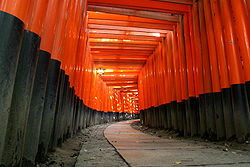- Fushimi Inari-taisha
-
Fushimi Inari Taisha
伏見稲荷大社
Torii leading to the inner shrine Information Type Inari Shrine Dedicated to Ukanomitama Founded 711 Address Fushimi-ku, Kyoto Phone +81-75-641-7331 Website 伏見稲荷大社 (in Japanese) Homepage Fushimi Inari Taisha (伏見稲荷大社) is the head shrine of Inari, located in Fushimi-ku, Kyoto, Japan. The shrine sits at the base of a mountain also named Inari, and includes trails up the mountain to many smaller shrines.
Since in early Japan Inari was seen as the patron of business, each of the Torii is donated by a Japanese business. First and foremost though, Inari is the god of rice.
Merchants and manufacturers worship Inari for wealth. Donated torii lining footpaths are part of the scenic view.
This popular shrine is said to have as many as 32,000 sub-shrines (bunsha (分社)) throughout Japan.[1]
Contents
History
 Haiden in front of honden
Haiden in front of honden
The shrine became the object of Imperial patronage during the early Heian period.[2] In 965, Emperor Murakami ordered that Imperial messengers were sent to report important events to the guardian kami of Japan. These heihaku were initially presented to 16 shrines including the Inari Shrine.[3]
From 1871 through 1946, Fushimi Inari-taisha was officially designated one of the Kanpei-taisha (官幣大社), meaning that it stood in the first rank of government supported shrines.[4]
Structures
The earliest structures were built in 711 on the Inariyama hill in southwestern Kyoto, but the shrine was re-located in 816 on the request of the monk Kūkai. The main shrine structure was built in 1499.[5] At the bottom of the hill are the main gate (楼門, rōmon, "tower gate") and the main shrine (御本殿, go-honden). Behind them, in the middle of the mountain, the inner shrine (奥宮, okumiya) is reachable by a path lined with thousands of torii. To the top of the mountain are tens of thousands of mounds (塚, tsuka) for private worship.
Fox
Foxes (kitsune), regarded as the messengers, are often found in Inari shrines. One attribute is a key (for the rice granary) in their mouths.
Unlike most Shinto shrines, Fushimi Inari Taisha, in keeping with typical Inari shrines, has an open view of the main idol object (a mirror).
A drawing in Kiyoshi Nozaki's Kitsune: Japan's Fox of Mystery, Romance and Humor in 1786 depicting the shrine says that its two-story entry gate was built by Toyotomi Hideyoshi.
The shrine draws several million worshipers over the Japanese New Year, 2.69 million for 3 days in 2006 reported by the police, the most in western Japan.
Access
The shrine is a three-minute walk from JR Nara Line Inari Station, 10 minutes from Kyoto Station. It is a five-minute walk from Keihan Electric RailwayMain Line Fushimi-Inari station.
Environs
In the approach to the shrine are a number of sweet shops dating tsujiura senbei (辻占煎餅), a form of fortune cookies dating at least to the 19th century, and which are believed by some to be the origin of the Chinese-American fortune cookie.[6][7]
Modern pop culture
- Memoirs of a Geisha (2005)
- Aria the Natural ep. 5 (2006)
See also
Notes
- ^ Motegi, Sadazumi. "Shamei Bunpu (Shrine Names and Distributions)". Encyclopedia of Shinto. http://eos.kokugakuin.ac.jp/modules/xwords/entry.php?entryID=776. Retrieved 31 March 2010.
- ^ Breen, John et al. (2000). Shinto in History: Ways of the Kami, pp. 74-75.
- ^ Ponsonby-Fane, Richard. (1962). Studies in Shinto and Shrines, pp. 116-117.
- ^ Ponsonby-Fane, Richard. (1959). The Imperial House of Japan, pp. 124.
- ^ Nussbaum, Louis-Frédéric et al. (1998). Japan encyclopedia, p. 224.
- ^ Lee, Jennifer 8. (January 16, 2008). "Solving a Riddle Wrapped in a Mystery Inside a Cookie" The New York Times. Retrieved on January 16, 2008.
- ^ 8. Lee, Jennifer (January 16, 2008). "Fortune Cookies are really from Japan.". The Fortune Cookie Chronicles. http://www.fortunecookiechronicles.com/2008/01/16/fortune-cookies-are-really-from-japan/.
References
- Breen, John and Mark Teeuwen. (2000). Shinto in History: Ways of the Kami. Honolulu: University of Hawaii Press. 10-ISBN 0-824-82363-X; 13-ISBN 978-0-8248-2363-4
- Nussbaum, Louis-Frédéric and Käthe Roth. (1998). Japan encyclopedia. Cambridge: Harvard University Press. 10-ISBN 0-674-01753-6; 13-ISBN 978-0-674-01753-5
- Ponsonby-Fane, Richard. (1962). Studies in Shinto and Shrines. Kyoto: Ponsonby Memorial Society. OCLC 399449
- ____________. (1959). The Imperial House of Japan. Kyoto: Ponsonby Memorial Society. OCLC 194887
Coordinates: 34°58′02″N 135°46′22″E / 34.96722°N 135.77278°E
External links
- Official Site (ja) (NB: music plays automatically on the top web page)
- Photographs of Fushimi Inari-taisha
- English visitor information
Shinto shrine Shinto architecture Buildings - chōzuya or temizuya
- haiden
- heiden
- hokora
- honden / shinden / shōden
- kagura-den
- massha
- sessha
Architectonic elements Styles - hirairi-zukuri
- tsumairi-zukuri
- gongen-zukuri
- hachiman-zukuri
- hiyoshi-zukuri
- irimoya-zukuri
- ishi-no-ma-zukuri
- kasuga-zukuri
- kibitsu-zukuri
- misedana-zukuri
- nagare-zukuri
- ōtori-zukuri
- owari-zukuri
- ryōnagare-zukuri
- shinmei-zukuri
- sumiyoshi-zukuri
- taisha-zukuri
Others Implements Main kami Staff Head shrines1 - Fushimi Inari Taisha
- Usa Hachiman-gū
- Ise Grand Shrine
- Dazaifu Tenman-gū
- Munakata Taisha
- Suwa Taisha
- Hiyoshi Taisha
- Kumano Nachi Taisha
- Tsushima Shrine
- Yasaka Shrine
Miscellaneous 1 (in order of the size of the shrine network they head)
Categories:- Kyoto
- Shinto shrines in Kyoto Prefecture
- Kyoto geography stubs
Wikimedia Foundation. 2010.

